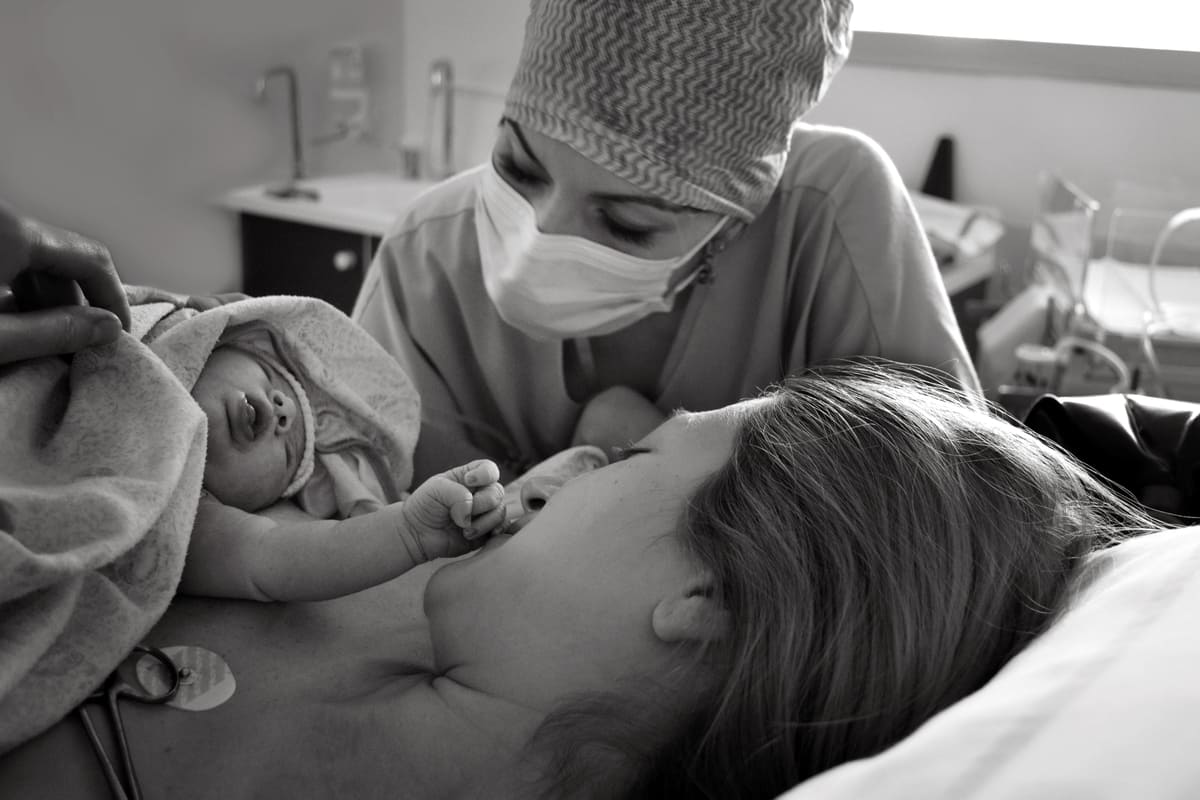Pregnancy is a beautiful and amazing time for most women. During this time, a lot of changes occur in the woman’s body to make room for the growing baby. There are also many decisions that have to be made, such as which type of delivery is best for both mother and child.
Though there are two types of deliveries, normal delivery also known as vaginal birth, and cesarean section, otherwise known as a C-section. A vaginal delivery or normal delivery is a natural way of giving birth. On the other hand, C-section is when the baby is surgically removed from the mother’s abdomen. Every woman is different, and the benefits of cesarean delivery compared to a normal delivery depend on her health. In this blog post, we will discuss the pros or cons of normal delivery versus C-section, so that you can make an informed decision.
In This Article
What is a normal birth delivery?
Normal birth or a vaginal birth delivery is the process of giving birth through the vagina without any complications. The baby is usually head down and facing the mother’s spine. The baby’s head begins to come out of the vagina, and the mother pushes to help deliver the baby. After the baby is born, the umbilical cord is clamped and cut, and then the baby is given to the mother to hold. The mode of vaginal delivery for a baby has been associated with certain benefits for both the mother and baby.

It’s Procedure:
- The cervix is dilated by the action of the contractions of the uterus. The contractions help to push the baby’s head down into the pelvis and also help to thin and open the cervix. The process of dilation can take many hours, or even days, depending on how long labor is.
- The second step is called “effacement.” This is when the cervix thins out and becomes shorter. This process also happens because of the contractions of the uterus.
- The third step is when the baby’s head begins to come down into the pelvis and engage in the birth canal.
- When the baby’s head is born, it is called “crowning.” After the baby is born, the umbilical cord is clamped and cut, and then the baby is given to the mother to hold.
What are the pros of normal birth delivery?
As we said to have a vaginal delivery is the most physiological way to give birth. According to a study, the women who had a vaginal delivery were less likely to have complications, like endometriosis, pelvic floor prolapse and incontinence. Below are some other pros of a vaginal delivery:
1. Shorter hospital stay
In a vaginal delivery, you will be discharged from the hospital sooner than if you had a cesarean. This is due to the fact that the recovery process after vaginal delivery is shorter and less complicated. You can expect to stay in the hospital for 24-48 hours after a vaginal delivery, while the hospital stay after a cesarean is typically two to four days.
2. Lower infection rates:
Infection rates are lower for vaginal births than for cesareans. This is because the vagina is a naturally sterile environment, while the abdomen and uterus are not. Through the birth canal, the baby is exposed to fewer germs, which lowers the risk of infection.
3. Less blood loss:
There is typically less blood loss during vaginal delivery than during a cesarean. This is because the uterine muscles contract more effectively during vaginal delivery, which helps to control bleeding.
4. Faster healing:
Recovery from vaginal delivery is typically quicker than recovery from a cesarean. This is because the incisions made during a cesarean are larger and take longer to heal. Additionally, women who have had a vaginal delivery can usually resume normal activities sooner than women who have had a cesarean.
5. Able to have a water birth:
While it’s not possible to have a water birth if you have a cesarean, it is possible to do so with a vaginal delivery. Many women find that being in the water helps them to relax and cope with the pain of childbirth. Moreover, water births have been shown to be just as safe as land births.

What are the cons of normal birth delivery?
The vaginal birth process can be quite excruciating. There are also cons associated with vaginal births that have to do with the baby and they are:
1. Risk of vaginal damage:
The delivery process can cause damage to the vaginal walls, which can lead to problems with incontinence later on in life. It also is at risk for prolapse, where organs like the bladder or rectum fall into the vagina due to weakened muscles and ligaments.
2. Perineal tearing:
This is a common occurrence during vaginal births and it is when the tissue between the vagina and anus tears. It can cause long-term issues such as incontinence and pain during sex. Moreover, it takes quite a while to heal from perineal tearing.
3. Episiotomy:
This is a surgical incision made in the perineum (the area between the vagina and anus) to enlarge the vaginal opening. It is often done when there is a need to hurry up the delivery or forceps are required. This too can cause long-term problems such as incontinence, pain during sex, and pelvic floor prolapse.
4. Weakness in the muscles of the waist:
The process of giving birth can cause the muscles in the waist to weaken and this can lead to hernias later on. Although vaginal delivery is considered the natural way to give birth, there are several cons that come along with it.
What is a C-section delivery?
Cesarean delivery (also known as a C-section) is a surgical procedure in which the baby is delivered through a cut (incision) in the mother’s abdomen and uterus. It is usually performed when there are problems with the baby or the birth, but can also be done for other reasons. Therefore, it reduces the medical complications that can occur during childbirth. In fact, in an emergency C-section would be the best option to save the life of both the mother and baby. Look at the below description of its procedure:

It’s Procedure:
- Cesarean delivery is a surgical procedure, so it is done in a hospital operating room.
- The mother is given anaesthesia (pain medicine) so she does not feel pain during the surgery.
- A large cut is made through the mother’s abdomen and uterus.
- The baby is delivered through this opening in the uterus.
- The umbilical cord is clamped and cut, and then the baby is given to the mother to hold.
- After the delivery, the incisions are closed with stitches. In a typical C-section, there are three to five incisions:
- Two small incisions are made in the mother’s abdomen.
- One large incision is made in the uterus.
- One small incision is made in the woman’s vagina (if necessary).
- The recovery time for cesarean delivery is usually longer than for vaginal delivery.
What are the pros of C-section delivery?
Hence, C-section delivery also has some advantages if you want to consider this method. Look at below to know:
1. It is efficient and predictable:
A C-section is a scheduled surgery, which means that you will know the date and time when your baby will be born. This can be helpful if you want to plan your delivery and postpartum recovery in advance. You will also have a team of medical professionals with you during the surgery, so you can be sure that you and your baby are in good hands.
2. Parents can choose a date and schedule:
The other advantage is that the date of delivery can be planned. In other words, both you and your doctor can schedule the C-section ahead of time. This is unlike a vaginal birth where the baby comes when he or she wants to come. For mothers who want to plan everything in their life, a C-section can be a good option.
3. Protects the mother from stress incontinence:
Stress incontinence is a type of urinary incontinence that can happen during pregnancy and after childbirth. It is caused by the weakening of the pelvic floor muscles, which support the bladder. According to a study, C-section delivery may help to reduce stress incontinence.
4. Reduces the mortality rate in infants:
C-section delivery may also be beneficial for infants. In fact, a study has shown that C-section delivery can reduce the mortality rate in infants by up to 40%. Additionally, C-section delivery for the baby may be recommended if the baby is in a breech position or if there are other complications.

What are the cons of C-section delivery?
C-section delivery has a few disadvantages when compared to normal delivery. For one, C-sections are generally more expensive than normal deliveries. Below are some serious disadvantages of C-section delivery and they are:
1. Blood clot:
The risk of having a blood clot is higher after a C-section than it is after a vaginal delivery. If you have had a C-section, be sure to ask your doctor how soon you can start moving around. Although the blood clotting in C-sections is higher, it can still happen during vaginal births.
2. Surgical site pain:
You will likely experience more pain at your incision site if you have a C-section. This is because the incision is usually deeper than it would be for a vaginal delivery. You can ask your doctor about taking pain medication to help with this discomfort.
3. Extended payback period:
It usually takes longer to recover from a C-section than it does from a vaginal delivery. This is because you have had surgery and your body needs time to heal. Recovery times vary from woman to woman, but you can typically expect to take at least six weeks before you feel like yourself again.
4. Weakness of the abdominal muscles:
The abdominal muscles are weakened after a C-section. This can cause back pain and make it difficult to do some activities, such as lifting things or exercising. Be sure to talk to your doctor about exercises you can do to help strengthen your abdominal muscles.
5. Complications in future pregnancies:
If you have a C-section, you are more likely to have complications in future pregnancies. This is because the scar tissue from your previous C-section can cause problems, such as the placenta attaching itself to the scar tissue (placenta accreta). Additionally, if you have had multiple C-sections, you may be at risk of your uterus rupturing during future pregnancies.
Why do doctors prefer C-sections?
C-section rates have been on the rise in the U.S. and worldwide. In 2015, 1 in 3 babies born in the U.S. were delivered via c-section, and the rate is even higher in other countries like Brazil (56%) and China (38%).
There are a few reasons why doctors may prefer C-sections. One reason is that it can be a faster delivery method than vaginal birth, which can be important if there are concerns about the baby’s health or the mother’s health. Additionally, C-sections tend to result in fewer complications than vaginal births, and they offer a higher degree of control for the doctor during delivery.
Are C-section babies smarter?
It’s a myth that C-section babies are smarter. There is no scientific evidence to support this claim. In fact, several studies have shown that there is no difference in intelligence between C-section and vaginal birth babies. So, whether you have a C-section or vaginal birth, your baby will be just as smart as any other baby.
Why do people avoid C-sections?
There are a few reasons why people may avoid C-sections. First, it is major surgery with risks and potential complications that come with any surgery. Secondly, C-sections often involve a longer recovery time than vaginal births. Finally, some people believe that C-sections are unnecessary and prefer to avoid them if possible. That being said, there are also many reasons why people opt for C-sections. In some cases, it may be the best option for the health of the mother or child. For example, C-sections may be recommended if the baby is in distress or if the mother has medical conditions that make vaginal birth too risky.
Do C-section babies have more problems?
There is no scientific evidence to support the claim that C-section babies are more prone to health problems. However, there are some risks associated with C-section births that can impact the baby’s health. For example, babies born via C-section may have a higher risk of developing asthma, allergies, and other respiratory problems.
The Bottom line
Therefore, after analyzing both the pros and cons of normal delivery and c-section, we can say that though both have their own advantages and disadvantages, ultimately it is the decision of the parents to choose what they think is best for their child. If you are someone who is pregnant or planning to get pregnant, then do consult with your doctor and make an informed decision. We hope you found this article helpful. If you have any doubts or queries, feel free to reach out to us in the comments section below. Stay tuned for more such informative articles!











